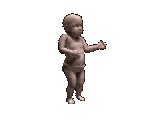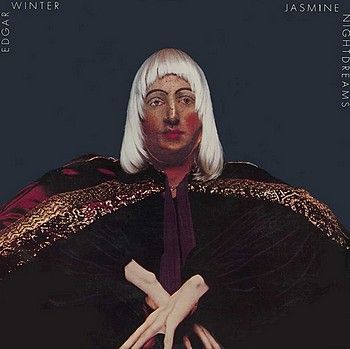
Donald Fagen - 10 Extras Bonus CD from Nightfly Trilogy - 2007 - Warner Brothers
Chances are, Donald Fagen didn't envision The Nightfly as the beginning of a trilogy when he released it in 1982, but as he slowly toiled away at his solo career, its blend of autobiography and smooth, soulful jazz became the template for his music outside of Steely Dan. As the albums slowly unveiled, it became evident that each covered a different stage in Fagen's life: the first, 1982's The Nightfly, was a wry nostalgic look back at his younger years; the second, 1993's Kamakiriad, was middle-age with a sci-fi spin; the third, 2006's Morph the Cat, looked at mortality through the veil of the new frontier of the post-9/11 world. Each album felt more personal than a Steely Dan record and also had a similar sound — reminiscent of Gaucho, but with an even heavier jazz bent — so they fit together well as a trilogy, each gaining strength from the other two, so it makes sense that Rhino would package them as a box set called The Nightfly Trilogy. In many ways, this box is indeed essential to Fagen diehards, as it adds a fourth disc of rarities, including soundtrack contributions and unreleased songs, along with 5.1 mixes of the three albums and all the music videos for each record. Given this generous bonus material, it's slightly frustrating that The Nightfly Trilogy is presented as a collection of MVIs — aka Music Video Interactive — which is partially spectacular and partially irritating. MVIs are designed to play in either computers or DVD players — not CD players, hence the "bonus" CDs of the three albums, bonus CDs that do not contain the bonus tracks on the set; those are compiled on a separate fourth CD — as those are the players that can take full advantage of the multimedia capabilities of the MVI, playing the video footage and the high-resolution Surround Sound mixes, and there are "easy to load" MP3s so you can transfer the files to a portable player and they have liner notes embedded on the disc. Sounds good, but it's not the easiest thing to use, as there is, naturally, a separate application on each of the discs to run the audio and showcase the extra material, which is the only way to access the very good liner notes here, as none of the discs have inserts bearing either credits or Fagen's track-by-track breakdowns. In theory, it's nice to have this all digitally, but it's hard not to wish that you could just open up a booklet and read it all at once instead of cycling through each individual disc. Also, the bonus CDs do not necessarily read in computers, which is frustrating, even if the MVIs have the MP3s embedded on them (including MP3s of the bonus tracks compiled on the separate CD that is readable by computer; the bonus tracks on the MVIs lack artist or title information, however). Despite these format problems, The Nightfly Trilogy is easy to recommend to Fagen diehards, as the three DVD Surround mixes do indeed sound great and it's quite wonderful to have the music videos for all three albums at easy disposal. Plus, there's the bonus material, which contains a wealth of great music, highlighted by "True Companion" (taken from the 1981 soundtrack to Heavy Metal); "Century's End" (taken from the 1985 soundtrack to Bright Lights, Big City); "Big Noise New York," which Fagen wrote for a Spike Lee film but was never used; the publishing demo "Confide in Me"; "Hank's Pad," a reworked Henry Mancini instrumental from Peter Gunn to which Fagen added lyrics; and, most of all, a terrific cover of Al Green's "Rhymes," co-produced by and featuring Todd Rundgren. There's not a bad cut on this ten-track bonus disc, and it's a sublime supplement that helps justify the purchase of this maddening but ultimately satisfying box. Stephen Thomas Erlewine © 2010 Rovi Corporation. All Rights Reserved http://www.allmusic.com/cg/amg.dll?p=amg&sql=10:jcfexq9rldhe~T1
The genius that is Donald Fagen was involved in two of the greatest jazz rock albums of the 20th Century, namely Steely Dan's "Aja" album, and his own solo "The Nightfly" album. This 10 track bonus CD was released as part of the Nightfly Trilogy box set, which also contained Donald's "The Nightfly", "Kamakiriad", and "Morph The Cat" albums, along with three more bonus audio, and 3-MVI DVD bonus video features. The music on this bonus disc speaks for itself. Some of the highlights include a live retake of Mancini's "Pete's Pad" called "Hank's Pad" here with lyrics by Donald Fagen, "Viva Viva Rock "n" Roll" a hard-rocking live track from Donald's tour in support of his "Morph The Cat" album, (The latter two tracks mentioned have previously only been available on poor quality soundboard recordings. This is their first official release),"True Companion," from the soundtrack to the 1981 movie Heavy Metal (1981), which features a terrific performance by Steve Khan on acoustic and electric guitars, "Century's End," from the soundtrack to the 1988 Bright Lights, Big City movie, a brilliant funk track that uses the same synth harmonica that Don used on The Nightfly's "I.G.Y", and "Green Flower Street" is from the wonderful New York Rock & Soul Review "Live At The Beacon" album. If you are a Steely Dan fan you probably have all these tracks in your collection, however it's still great to hear a collection of tracks from one of the greatest jazz rock musicians of all time. Check out the amazing credits on this album! The album is
VHR by A.O.O.F.C. [All Tracks @ 320 Kbps: File size = 104 Mb]
BONUS CD 4
TRACKS / COMPOSERS
01. Rhymes - Al Green, Mabon "Teenie" Hodges, Leslie Sarony
02. Big Noise New York - Donald Fagen (Music), Marcelle Clements (Lyrics)
03. True Companion - Donald Fagen
04. Confide In Me - Donald Fagen
05. Blue Lou - Donald Fagen
06. Shanghai Confidential - Jerry Leiber, Mike Stoller
07. Green Flower Street (Live) - Donald Fagen
08. Century's End - Donald Fagen, Timothy Meher
09. Hank's Pad (Live) [retake of Henry Mancini"s "Pete"s Pad"] - Donald Fagen (Lyrics), Henry Mancini (Music)
10. Viva Via Rock N Roll (Live) - Chuck Berry
MUSICIANS
Donald Fagen: vocals, tambourine (1), keyboard sequencing (2), backup vocals (2, 4), piano (3, 4), kalimba (3), keyboards (6, 8), sequencing (6, 8), melodica (7), Fender piano (10)
Wayne Krantz: guitar (1, 10)
Drew Zingg: guitar (4, 7)
Steve Khan: guitar (6)
Jon Herrington: guitar (9, 10)
Georg Wadenius: guitar (8)
Tom Barney: bass guitar (9)
Will Lee: bass (3)
Lincoln Schleiffer: bass (4, 7)
Marcus Miller: bass (6)
Jimmy Haslip: bass (8)
Freddie Washington: bass guitar (10)
Don Grolnick: Fender piano (3)
Ted Baker: piano (9)
Todd Rundgren: keyboards, sequencing and backup vocals (1)
Jeff Young: organ (4, 6), backup vocals (6), piano (7)
Keith Carlock: drums (10)
Steve Jordan: drums (3)
Denny McDermott: drums (4, 7)
Leroy Clouden: drums (8)
Ricky Lawson: drums (9)
Crusher Bennett: percussion (3)
Manolo Badrena: percussion (6)
Walt Weiskopf: tenor saxophone (1, 10), alto saxophone (1)
Bob Sheppard: tenor saxophone (9), tenor saxophone solo (9)
Lou Marini: tenor saxophone (5)
John Hagen: tenor saxophone (7)
Cornelius Bumpus: tenor saxophone (7, 9)
Harold Vick: tenor saxophone (8)
Ronnie Cuber: baritone saxophone (8)
Michael Leonhard: trumpet (1, 9, 10)
Chris Anderson: trumpet (7)
Lew Soloff: trumpet (8)
Larry Farrell: trombone (1)
Dave Bargeron: trombone (8)
Jim Pugh: trombone (9)
Mindy Jostyn: backup vocals (4, 7), harmonica (4)
Zack Sanders: vocals (3), backup vocals (8)
Amy Helm: backup vocals and whistling (1)
Ula Hedwig: backujp vocals (7)
Dian Sorel: backup vocals (7)
Frank Floyd: backup vocals (8)
Angela Patrick: backup vocals (8)
Carolyn Leonhard: backup vocals (9, 10)
Victoria Cave: backup vocals (9)
Cindy Calhoun: backup vocals (9)
Cindy Mizelle: backup vocals (10)
The Joe Roccisano Orchestra (5)
VERY SHORT BIO
Donald Fagen was one of the two masterminds behind Steely Dan, the seminal jazz-pop band of the '70s. Fagen's solo work has been a continuation of the band's work of the early '80s — carefully constructed and arranged, intricately detailed pop songs that are more substantial than their stylish surface may indicate. His 1982 solo debut, The Nightfly, was the best album he had made in years; it covered the same ground as the last two Steely Dan albums, yet surpassed them in terms of ambition and achievement. After the success of The Nightfly, Fagen suffered a case of writer's block; for the rest of the decade he contributed music to the occasional film and briefly wrote a column for Premiere magazine in the mid-'80s. In the early '90s, he toured with the New York Rock and Soul Revue as he finished the material for his second album. With his former Steely Dan partner Walter Becker producing, 1993's Kamakiriad sounded like Aja recorded with '90s technology. It had some success on the adult contemporary charts, but it was overshadowed by the duo's decision to re-form Steely Dan and tour for the first time in nearly 20 years; the tour was a massive success. One more album — 2003's Everything Must Go — came out of the reunion before Fagen decided to begin work on his third solo album. With death as its main theme, Morph the Cat appeared in March 2006. Soon after the album's release, Fagen embarked on his first solo tour. © Stephen Thomas Erlewine © 2010 Rovi Corporation. All Rights Reserved http://www.allmusic.com/cg/amg.dll?p=amg&sql=11:3ifwxqe5ldje~T1



















